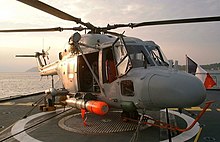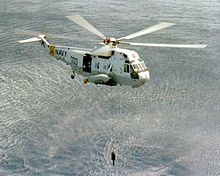Underground hunt
U-Jagd is a term in German military language and describes the fight against enemy submarines . The term in the technical language of the Volksmarine was anti-submarine defense (UAW); The term "Anti-Submarine Warfare" (ASW) is used in NATO linguistic usage and in English.
history
During the First World War , the depth charge was the only weapon specially developed for combating submarines. She was pushed from the stern of a warship after the detonation depth was manually adjusted. Underwater directional microphones ( hydrophones , also passive sonar) were used to track down submarines , the development of which was still in its infancy at that time and which were still quite unreliable due to the high level of noise, especially in convoys or fleet units.
The best way to spot a submarine was by sighting it, because a submarine had to go to periscope depth to attack in order to use its torpedoes . It had to emerge completely to use its on-board guns. The countermeasures were initially conventional, many submarines were sunk by ship artillery or by ramming.
During the Second World War , active sonar and the introduction of radar enabled Allied warships to search actively and at night for submarines for the first time, whereas previously they largely had to wait for a submarine to attack or betrayed it by showing up during the day. Radio traffic from the submarines was also intercepted and, if possible, a radio direction finding was carried out in association with other ships or listening stations. The Allies used the Huff-Duff for this .
Large numbers of small escort ships were built to protect Allied convoys, such as the Flower class corvettes . The Flower Corvettes already had radar, but this was still turned by hand using a steering wheel from the automotive industry. Their anti-submarine weapon was the Hedgehog , a forward-facing multiple mortar that could fire up to 24 impact fuze shells at the same time. If a commander wanted to attack a submarine, he drove towards his target at top speed and gave the order to fire at a distance of as close as possible to 230 m.
As early as 1939, the Royal Navy developed a special ASW ship type, the so-called sloop . The sloops of the Black Swan class , which achieved outstanding success in anti-submarine defense during the war, became famous. Depth charges continued to be used, but these were now increasingly fired by launchers such as the British Squid or his successor Limbo and were thus able to cover a much larger area and carry heavier explosive charges without endangering the deploying ship in the event of the explosion.
The use of aircraft, which could surprise submarines and at least severely damage them with on-board weapons or light depth charges, played an increasingly important role.
Another method was the laying of sea mines in the approaches to the submarine bases. Ports were also protected by nets or cables against submarines and the torpedoes they fired.
Modern submarine hunting

After the Second World War, the frigate developed into a typical ASW ship. Most of the larger surface units entrusted with the main task of submarine hunting have one or two on- board helicopters , which can be used to locate and combat submarines. In addition, helicopter carriers are also used for submarine hunting (e.g. Japanese Hyūga class ).
During the Cold War , the class of hunting submarines ( SSN ) was also created, the main task of which is to hunt down enemy submarines. Today, the extensive anti-submarine combat is also carried out by special aircraft such as B. the Breguet Atlantic , Lockheed P-3 , Lockheed S-3 or the Boeing P-8 .
Location
Even today, in addition to radar, active and passive sonar are the most important means of locating a submarine. With the help of computers, ambient noise and emissions from known ships are filtered out and a targeted search is made for the noise signatures of submarines. In addition to the ship sonar, on- board helicopters can deploy diving sonar or sonar buoys and thus expand the reconnaissance area considerably.
Modern warships have special devices such as the AN / BQQ-5 tow sonar, which, for example , is pulled up to 800 m behind the ship in the Los Angeles class of hunting submarines . This has several advantages: the ship's own noise affects the measurement less, 360 ° observation is possible and the tell-tale sonar signature does not come from the ship itself.
The French frigates of the Georges Leygues class use a depth-variable towing sonar that can be lowered into different layers of water in order to track down submarines that are hiding, for example, in a layer of cold water, undetected by the on-board sonar.
From 1950 until around the end of the Cold War , NATO operated the SOSUS underwater interception system , which consists of a network of stationary, passive sonar systems that were sunk across the board on the sea floor. Similar wiretapping systems are also operated by non-NATO countries, on a smaller scale, for coastal protection.
Another modern device is the MAD ( Magnetic Anomaly Detector ), which is used by airplanes or helicopters and registers changes in the earth's magnetic field, such as those typically caused by submarines.
Combat
Older ships are equipped with Squid - equipped launchers Limbo or the depth charges over a certain distance in the direction of the submarine position fling. The most important ASW weapon today is the torpedo equipped with a sonar target seeker . In NATO , the MK46 lightweight torpedo is standard, but other models such as the MU90 torpedo are also used. The lightweight torpedoes used regularly have a caliber of 324mm. Corresponding torpedo tubes are available on board the ships , and they are also used from airplanes and the on-board helicopters.
With the appearance of fast, nuclear-powered submarines in the 1960s, especially the Russian Alfa class , a problem in anti-submarine defense became clear: Modern nuclear submarines were sometimes faster than the torpedoes available at the time or destroyers and could therefore practically not be fought.
The ASROC system was therefore introduced in the USA : a torpedo (today (2006) mostly of the MK46 type) which is brought close to its target by a rocket. A similar system, the SS-N-14 Silex, is used on ships of the former Warsaw Pact . Another advantage of this missile-torpedo combination is that it can be used to fight submarines quickly, even at greater distances. Probably the most notable weapons were the Subroc and SS-N-16 used by hunting submarines , which can be launched both vertically and from the torpedo tubes. From the submerged submarine, this rocket rises to the surface, ignites there, flies over its target and then parachutes a torpedo that can descend several hundred meters. In the US, is now out of Vertical Launching Systems bootable RUM-139 VL-ASROC in use.
literature
- David Miller, Chris Miller: Modern Warships . 4th edition. Motorbuch-Verlag, Stuttgart 2001, ISBN 3-7276-7093-2
- Werner Globke (ed.): Weyers Flottentaschenbuch / Warships of the World - Fleet Handbook , Bernard & Graefe Verlag, Bonn, 66th year 2005-2007, ISBN 3-7637-4517-3





